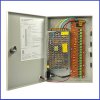pete_c
Guru
Over the last two years or so I have been converting my outdoor mostly Halogen 12VAC outdoor lighting to LED; a bit at a time.
The current set up is driving by 4 1000 Watt Toroidal multitap/multivoltage commercial landscape transformers mounted inside of the home to one side of the fuse panel (maybe 15 feet away) each one with an individual breaker in the panel.
The wiring is all 12/14 guage to multiple small zones outside. All of the current new LED lighting is 12VDC/AC anwhere from 1/2 watt to 4 watt LED lighting. For example the adjacent to the front of the house lighting is divided into like 5 zones with 5 separate home wired feeds.
I'm looking to start switching over the LED lighting zone by zone to smaller 12VDC transformers and looking for suggestions.
Is there such a 12VDC multiline distributed voltage type transformer I can utilize? I am today using one 12 camera PS with individual fuse links. Is there something similiar with more amperage per load made for LED lighting available?
I'm looking to alleviate a bit of wall clutter (the four commercial toroidal transformers have large footprints), power and trying to keep separately fused links for each zone.
I found a relatively small 60 Watt 12VDC PS. Could I just put a number of these across a piece of plywood to supply power to the LEDs?
How does the 12VDC PS work with multiple runs that are over 200 feet?
Has anyone done anything like this yet?
The current set up is driving by 4 1000 Watt Toroidal multitap/multivoltage commercial landscape transformers mounted inside of the home to one side of the fuse panel (maybe 15 feet away) each one with an individual breaker in the panel.
The wiring is all 12/14 guage to multiple small zones outside. All of the current new LED lighting is 12VDC/AC anwhere from 1/2 watt to 4 watt LED lighting. For example the adjacent to the front of the house lighting is divided into like 5 zones with 5 separate home wired feeds.
I'm looking to start switching over the LED lighting zone by zone to smaller 12VDC transformers and looking for suggestions.
Is there such a 12VDC multiline distributed voltage type transformer I can utilize? I am today using one 12 camera PS with individual fuse links. Is there something similiar with more amperage per load made for LED lighting available?
I'm looking to alleviate a bit of wall clutter (the four commercial toroidal transformers have large footprints), power and trying to keep separately fused links for each zone.
I found a relatively small 60 Watt 12VDC PS. Could I just put a number of these across a piece of plywood to supply power to the LEDs?
How does the 12VDC PS work with multiple runs that are over 200 feet?
Has anyone done anything like this yet?



